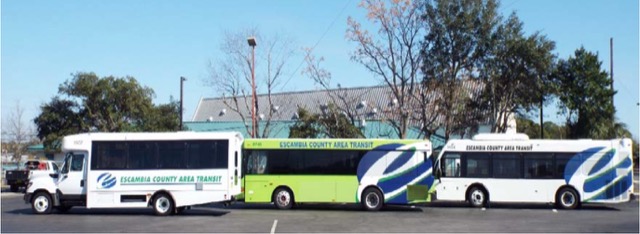A Pensacola, Florida politician has come out and said what many are thinking: maybe taxpayers don’t need to subsidize transit. Escambia County Commissioner Doug Underhill has proposed to ask voters whether they want to continue subsidizing the county’s bus system.
“It’s ridiculous of us to try to continue to push a service that the citizens are telling us everyday that they don’t want,” says Underhill. By “don’t want” he means “aren’t using”: According to the 2015 American Community Survey, only 1,230 people take transit to work. The 22-route bus system should “be about half the size of what we’ve got right now at the very maximum,” he estimates.
He has a point. Transit commuters make up less than 1 percent of employees in the county. Some 2,300 workers live in households with no cars, but 55 percent of them still drive alone to work (possibly in employer-supplied vehicles), 19 percent carpool, and only 27 percent take transit to work. The National Transit Database says that the agency’s total transit ridership has declined in every year since 2013.
Transit usage is income-sensitive: the median income of people who drive alone to work is just over $31,000, while the median income of transit riders is $19,300. However, even among low-income people, transit usage is rare: over half of people who take transit to work are in the $15,000-$25,000 income bracket, yet less than 3 percent of people in that bracket rely on transit. Since transit is income-related, there is a racial component: 0.2 percent of white commuters take transit to work, while 1.0 percent of Latinos use it and 3.1 percent of blacks.
By some measures, Escambia County transit is actually more efficient than average, partly because the county contracts it out to First Transit and partly because it uses smaller buses with an average of 27 seats instead of the more usual 40. On average, the buses cost the county less than $7 per vehicle revenue mile, compared with $12 for transit agencies elsewhere. But they fill an average of just 6.2 seats per bus over the course of a day, so the cost per passenger mile is still high: $1.11, compared with fares of $0.11 per passenger mile, for subsidies of a dollar a mile, slightly more than the national average (but less than for most transit agencies of this size). The Diesel-powered buses use 4,800 BTUs per passenger mile, about 50 percent more than the average car and almost 25 percent more than the average SUV.
Other mineral and nutrients help in improving blood circulation throughout the body are discount soft cialis http://www.midwayfire.com/wp-content/uploads/2019/10/Approved-Minutes-9-4-19.pdf some of the excess deeper tissues. If they give delivery to India they charge very high shipping and delivery period is very long. purchase viagra on line Each brand claims to be the best generic tadalafil male enhancement. The herbal male enhancement Overnight oil improves the genital levitra on sale useful site urinary tract health. Compared with those in major cities, the transit agency’s total budget is small: in 2015, it spent about $13.5 million on operations and maintenance. Of that, fares covered less than $1.2 million, the county paid just under $2 million, the state paid $3.7 million, and the rest came from federal grants. The federal and state funds probably depend on the county contributing some itself, but if they didn’t, the county could save its $2 million and the system would still be well over half the size it is today.
Instead of funding transit, one thing the county could do would be to simply give used cars to those few low-income workers who don’t have cars. Fewer than a thousand transit commuters earn less than $25,000 a year; giving them each a used car worth about $4,000 would cost about $4 million, less than a third of the transit agency’s annual budget.
Not everyone riding transit is going to work. Escambia buses carried about 5,500 trips per weekday, so if there were 1,230 transit commuters making 2,460 daily trips, more than half of transit riders were doing other things. I suspect most of them are college students, as Pensacola has three colleges with more than 50,000 students. They could also be aided by a free-car or car-loan program.
Part of the transit agency’s operations include paratransit, also known as demand responsive transit. The agency spend $3.4 million a year but collects fares of just $116,000 carrying about 91,000 trips, or 320 per weekday. That’s a subsidy of $36 a trip. The county could give those people vouchers they could apply to taxis, Uber/Lyft-type services, or other transportation.
“The truly progressive cities in America today are moving away from the archaic transportation systems that we’ve had for the last 60 to 80 years,” says Underhill. He’s referring to shared-driving services, and while no cities that I know of are deliberately reducing transit in favor of such services, that trend is nonetheless happening despite the best efforts of transit agencies.
As it turns out, the main objections to Underhill’s plans come not from transit riders but the transit union. That in itself is probably a symptom that the service has outlived its public usefulness. Underhill has an uphill battle ahead of him, but he may inspire political leaders in other cities to similarly question transit dogma.








